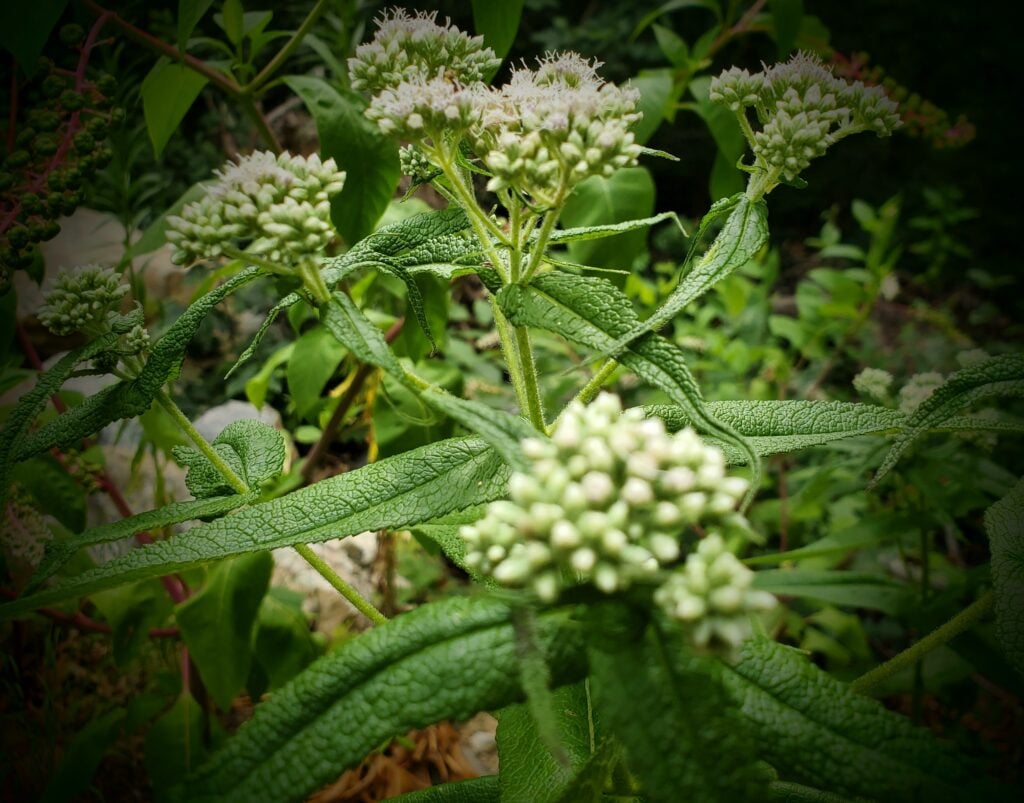The Outdoor Apothecary is reader-supported. When you buy through links on our site, we may earn an affiliate commission. Learn more
While you might have never heard of the herb boneset, it has been used for centuries for its medicinal uses. It is best known as a fever reducer, digestive aid, pain reliever and to stop coughs.
I am lucky enough to have some growing on my property and like to keep some on hand should we need it during cold and flu season.
On this page, you will learn all about the herb boneset and its traditional and medicinal uses.
Boneset (eupatorium perfoliatum)
Folk names: Agueweed, Crosswort, Feverwort, Indian Sage, Sweating Plant, Teasle, Thoroughwort, Wood Boneset
What is the Herb Boneset?
Common Boneset is a plant in the aster family. It is characterized by its coarse, rough, hairy aspect; it grows up to 6 feet tall. Its leaves are what really define it: lance-shaped, taper-pointed, toothed, wrinkled, and very veiny. The 4-8 inch leaves are joined together at their bases around the stem of the plant. In August, it produces fragrant flower heads that open revealing small white tubular flowers in numerous heads arranged in a multi-branched cluster up to 10 inches wide.
History and Folklore
The herb Boneset has been used by Native Americans for centuries to treat colds, fever, and rheumatic pain. European settlers learned of the herb boneset and its benefits, and by the 18th and 19th centuries, it was regarded as a virtual cure-all. The common name derives from its ability to treat “break-bone fever” (or dengue fever), a mosquito-born illness once common in wet places in North America. The herb was also used historically to treat malaria.

Identifying the herb Boneset
You can identify the herb boneset by its distinctive appearance and by these characteristics:
- Height: Boneset is a native perennial wildflower that can grow 2–4 feet tall.
- Stem: The central stem is covered in long white hairs and is unbranched, except for a few flowering side stems near the very top.
- Leaves: The leaves are lanceolate, tapering to a point, and grow up to 8 inches long and 2 inches across. The bases of the leaves tend to grow together, making it seem as if the central stem perforates the leaves.
- Flowers: Boneset produces clusters of fragrant white flowers in late summer or early fall. Each composite flowerhead contains ten to twenty florets with a shaggy appearance.
- Seeds: The florets produce tiny, dry seeds that are dispersed by the wind and have hairlike bristles.
- Roots: Boneset’s fibrous root system often produces rhizomes, or horizontal stems with shoots that grow above ground and roots that remain below the surface. This system can help boneset spread over large areas, creating a colony of plants.

Where, When, and How to Wildcraft
The herb boneset grows in a variety of wetland habitats across eastern North America, from Quebec south to Florida and west to Texas and Manitoba. Traditionally, it is most commonly used for colds and flu and can grow in meadows, marshlands, and sometimes even roadside ditches and prefers full or partial sun.
The upper third of the plant is hand-picked in late summer and early fall, when it is in bloom and dried. They can be brewed into a tea or made into a tincture that can be added to foods and beverages.
The Amazing Benefits Of Boneset Tea & How To Make It At Home
Medicinal Uses
Boneset is often used in herbal traditions to support the body during fevers, colds, and digestive discomforts.
Known for its anti-inflammatory, antispasmodic, expectorant, and diaphoretic properties, boneset, when combined with elderflower and spearmint, can be enjoyed as a tea to help with flu-like symptoms. It is believed to ease respiratory congestion, provide comfort during fevers, and soothe general aches.
Additionally, boneset tea is thought to help stimulate appetite and ease occasional constipation. Many herbalists find it particularly supportive for those experiencing poor appetite, general weakness, and abdominal discomfort.

Harvest Sustainably
If you find boneset in the wild, be careful to leave enough behind so that the plant can regenerate. It’s a good rule of thumb to only harvest the aerial parts of a small portion of the plants. Propagate boneset by dividing plants when they go to seed in the fall or when they start to grow new shoots in spring.
You can read more about foraging sustainably here: 9 Basic Principles of Ethical Wildcrafting for Beginners
Caution
Boneset is a wonderful herb, but it must be used in moderation. If you have liver problems or are pregnant or breastfeeding a baby, do not use this herb. Also, too strong a dose can potentially cause nausea and vomiting. Just cut it back next time. If you are allergic to chamomile, feverfew or ragwort, you may well have an allergic reaction to boneset. Otherwise, as I always say – DO YOUR RESEARCH- and be wise! See my full disclaimer below. To your health!
Disclaimer:
The Outdoor Apothecary website is intended for informational purposes only and should not be considered a substitute for professional medical advice. The information provided is not intended to diagnose, treat, cure, or prevent any disease. While we strive to provide accurate and up-to-date information, it is the reader’s responsibility to ensure proper plant identification and usage.
Please be aware that some plants are poisonous or can have serious adverse health effects. We are not health professionals, medical doctors, or nutritionists. It is essential to consult with qualified professionals for verification of nutritional information, health benefits, and any potential risks associated with edible and medicinal plants mentioned on this website.

